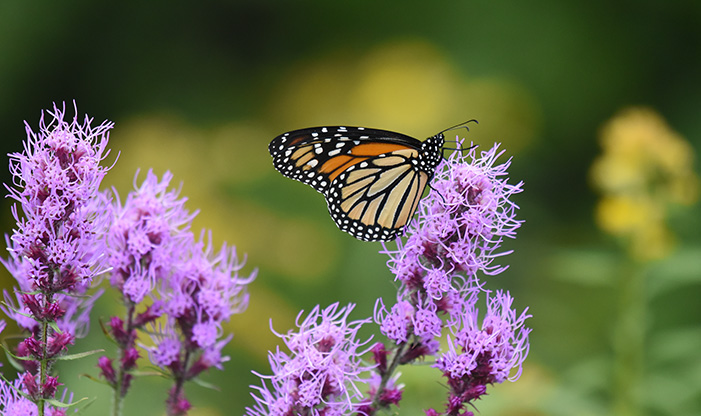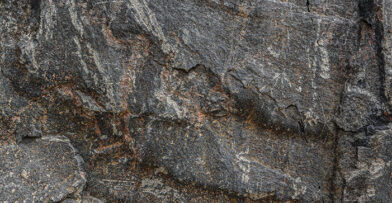Many creatures live in the prairie, and all of them contribute to its immense diversity. Some of the smallest creatures, the prairie insects, are of great significance in creating and maintaining this habitat. It could even be argued that without insects, the prairie would not exist.
Pollinating Wildflowers
By late August, there can be as many as 10 million insects per acre of tallgrass prairie, with many of them performing the work of pollinating it. The monarch butterfly is a member of the order Lepidoptera, which includes butterflies, moths, and skippers. It is one of the most important pollinators to wildflowers in this habitat. Monarchs are also indicators for the health of the environment, which is one reason they are studied. The male and female are distinguished by the male’s spot on each wing, which is a scent gland used to attract mates. The monarch is known for its incredible migration every September to Mexico’s Michoacán Mountains, whose location resides in the butterfly’s brain.
Native bees are important pollinators as well. There are almost a thousand species of native bees in the prairie. At the Center, sweat bees, mining bees, mason bees, and bumble bees live among them, including the federally endangered rusty-patched bumble bee. To help gather pollen, bees have specialized bristles made of chitin on their body which they use to make metaphorical baskets, which allow them to carry the pollen back to their nests. Monarchs and native bees pollinate 85% of the plants, including food crops.
Creating the World’s Richest Soils
The significance of prairie insects is shown in ants, a critical species that contributes to the overall prairie ecosystem. They create the rich soils that make it an abundant food source for all animals living there. Notably, the eastern and western mound builders tunnel down over four feet and aerate the soil, bringing up nutrients and rejuvenating the soil’s upper level. All animals living in this habitat benefit from the work of ants.
Grasshoppers are especially well adapted to prairie grasslands. They are a member of the order Orthoptera and are among the oldest group of chewing insects, feeding mostly on plants. Comprised of around 11,000 known species, they avoid predators with effective camouflage, and can also startle them with a quick jump or wing flash. Grasshoppers live for one year, mostly existing in the nymph stage and emerging for six weeks as an adult. Some grasshoppers will occasionally change their appearance and behavior and become locusts, which are migratory grasshoppers. They can then form swarms and cause devastation by eating crops and pasture. The greatest plant eaters of the insects can spell success or failure to a multitude of living things.
Prairie Insect with a Special Characteristic
Crickets are also of the order Orthoptera, and have cylindrical bodies, round heads, and long antenna. They are distantly related to grasshoppers, having a lifespan of 8-10 weeks. There are about 900 known species of crickets, which are a nocturnal species. They eat three-fourths of their body weight each day. This is significant as there may be 10,000 crickets on an acre of land. Most male crickets make a loud chirping sound by stridulation, which is the rubbing of their two wings together. The frequency of chirping varies according to temperature. For the “temperature cricket,” or snowy tree cricket, count the number of chirps in 15 seconds and then add 37. The number will be an approximation of the outside temperature in Fahrenheit.
There are many more prairie insects that are interesting and important to this habitat. Explore the Center’s rare wet prairie, located off of the Gateway Trail to see some of them. Late summer views will include the flurry of busy insects along with beautiful prairie wildflowers.


